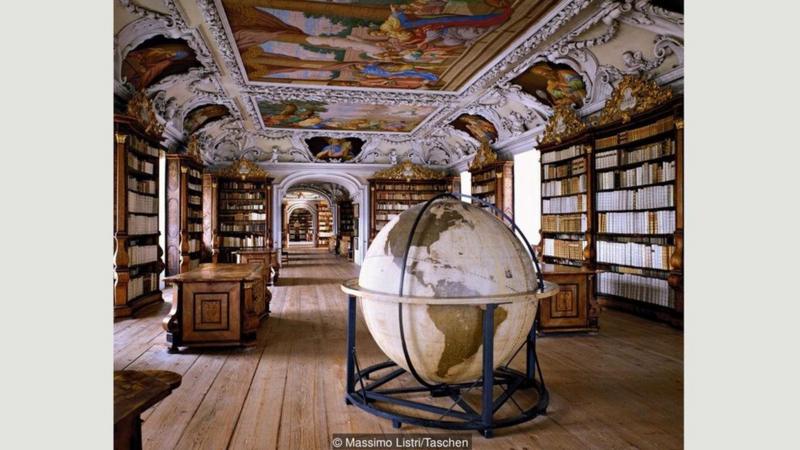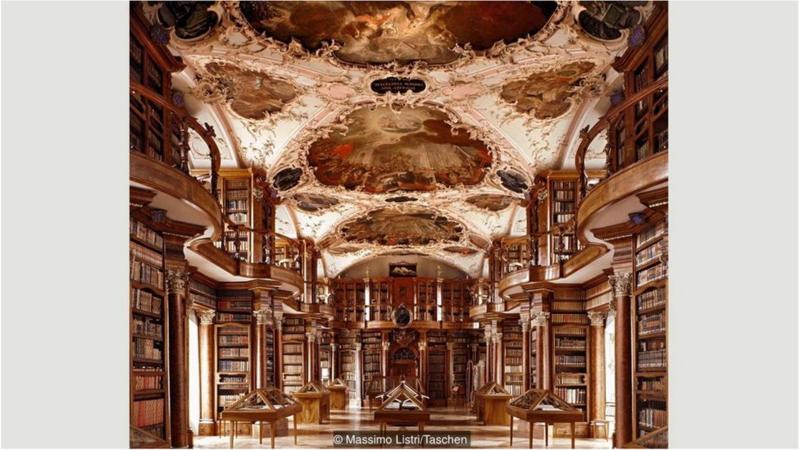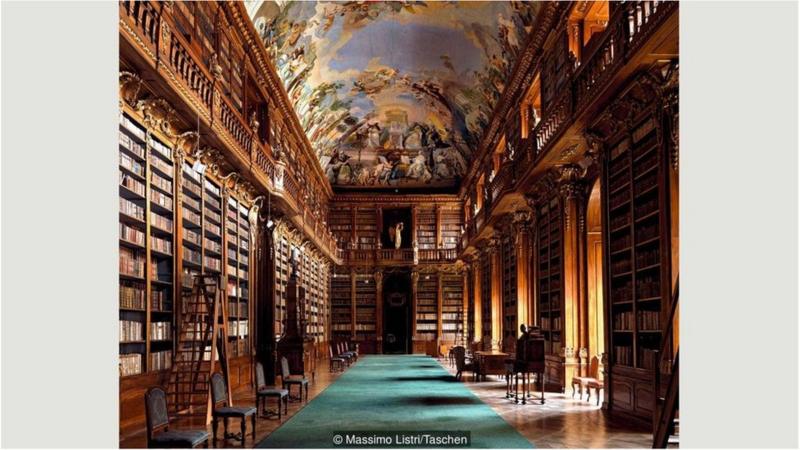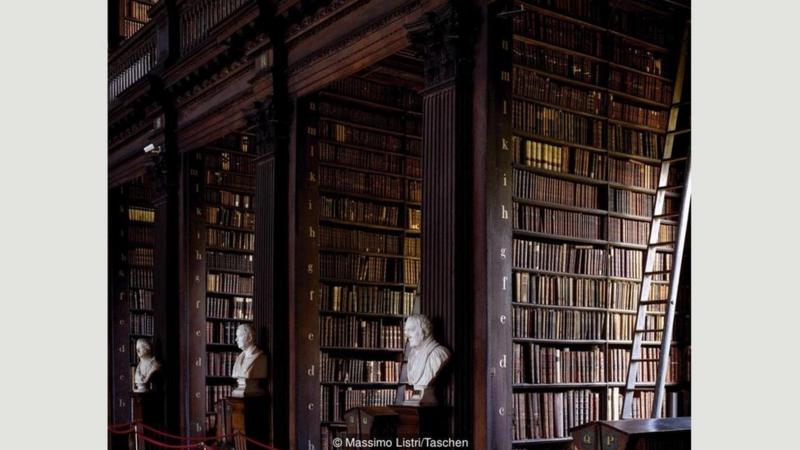A new book celebrates the world’s most beautiful libraries, many of them in Europe. Cameron Laux sees how this library holds records of world history from various periods, even surviving raids in the 10th century and looting in the 21st century by crime syndicates.
If you’re a fan of minimalism, it might be best to turn a blind eye. But if you, like the writer Jorge Luis Borges, believe that Heaven is a kind of library, then get ready, because you will be taken to heaven on earth.
A new book from Taschen, Massimo Listri:The World’s Most Beautiful Libraries , features images taken by Listri of the world’s oldest and most beautiful libraries, from medieval to 19th-century institutions and private collections and monasteries. This book has been called a ‘beauty pageant for bibliophiles’.

Biblioteca Apostolica Vaticana (The Vatican Library), Rome, Italy
The Vatican Library dates back to the 4th century AD, although its current form was only confirmed in the 15th century.
In the 16th century, Pope Sixtus V asked architect Domenico Fontana to build a new building that could store the Vatican collections. Until now this building is still in use.
The building’s decoration was so luxurious that its shape was a series of complex symmetrical geometries.
Like many other Vatican complexes, the library displays spiritual and worldly influences that allow the Vatican to assert its existence as a sovereign state.
Apart from containing various documents from throughout human civilization, this library also stores the oldest Bible manuscripts.
When the librarian here tells you to shut up, maybe you should listen because only cardinals can be librarians here.

Stiftsbibliothek Kremsmünster (Kremsmünster Abbey Library), Austria
Kremsmünster Church was founded in 777 BC. The church houses the Codex Millenarius, a famous Gospel manuscript from the 8th century that depicts Saint Luke as a flying bull (Matthew, Mark, and John are depicted as a winged man, a lion, and an eagle).
Apart from raids in the 10th century, the damage of which was later repaired by Emperor Henry II, Kremsmünster survived looting, destruction and aristocratic takeover.
It’s not surprising, because this church is located on a hill like a powerful fortress.
Like many libraries in Europe, the Kremsmünster was rebuilt in the Baroque style popular in the 17th century.
Most of the surface (thankfully not the floor) is elaborately decorated with carvings, embossed decorations, and paintings on the ceiling — however, this library could be said to be simpler compared to some other beautiful libraries.
Books as intellectual and cultural assets were once considered more valuable than jewels, so it made sense for them to store and display books in beautiful jewelry boxes.

Biblioteca Statale Oratoriana dei Girolamini ( Girolamini Library ), Naples, Italy
The Girolamini Library was part of a large complex founded by the Oratoria order.
The library hallway is an impressive space consisting of three elegant floors: two levels of carved bookcases, while the highlight is baroque plasterwork and fresco painting.
The volume of books displayed here strongly suggests that this is a place of learning and research as well as a storehouse of knowledge.
Although the collection is large, it is particularly strong in musical collections: the Oratorian order believes in the importance of music and song in religious contemplation.
Girolamini was the favorite library of the 18th century philosopher Giambattista Vico.
Unfortunately, this place has also witnessed looting in the 21st century. In 2012 it became known that a crime syndicate was systematically taking and selling valuable antique texts from this library on the market, although many have now been discovered.
This incident is a reminder that humanity’s written heritage — or as Unesco puts it, ‘the world’s memory’ — is under constant attack.

Bibliothèque Sainte-Geneviève (Sainte-Geneviève Library), Paris, France
Even though we know that this library may be older, information about this library document first appeared in 1148.
First founded as a convent library, it survived the chaotic years of the French Revolution (although the church it was part of was disbanded and converted into a school), and is now the university library of the Panthéon-Sorbonne, Paris 1.
The library’s collection grew with the dissolution of other religious institutions and with the confiscation of aristocratic collections.
The new church, built in the 18th century, was later converted into the Panthéon, where famous and important French people are buried.
This library was designed by architect Henri Labrouste and opened in 1851. Its large reading room has the impression of a cathedral in the Industrial Revolution Era; the iron frame construction is reminiscent of another great ‘cathedral’ of the era, the railway stations.
In a modern setting, tables for readers are placed in the center and books are arranged elegantly. Gas lamps were also used for the first time in monumental passageways.

Klosterbibliothek Metten (Metten Abbey Library), Germany
The Benedictine Abbey at Metten was first founded in 766, but was later squeezed by the Reformation, war, social tensions, secularization, and realpolitik.
Things came to a head in 1803, when the church’s property, including its library, was confiscated and auctioned off.
However, under the reign of King Ludwig I of Bavaria, the church was reopened and a new library was established; This location then becomes a source of knowledge and education again.
When the monastery was led by Abbot Märkl, this place was then turned into a palace for prelates (bishops or other church officials), according to the level of prestige it had.
One part of the impressive formal reception space is the library, which was designed according to a beautiful theological scheme. The result is a beautiful, dense and playful mix of materials.
The sculptor, Franz Josef Holzinger, was commissioned to create ‘atlantes’ on the central column to support the ceiling (as ordinary marble columns were not sufficient).
Scenes from the lives of important Christian figures such as Thomas Aquinas are depicted in ceiling paintings. One problem that may arise with the Rococo approach to building a ‘temple of knowledge’ is that we have to squint to find the book.

Stiftsbibliothek Sankt Gallen (Saint Gall Abbey Library), St Gallen, Switzerland
The St Gall Abbey building has long been one of the most important intellectual centers in Western Europe and within it, is home to one of the largest medieval libraries in the world.
The church was founded in the 7th century by the Irish monk Gallus, and followed the Rule of Saint Benedict — that most bookish of saints, who required his order to undertake disciplined contemplation of religious texts — for over a thousand years.
The Greek sculpture above the library’s entrance declares it to be ‘a safe place for the soul’.
The current library emerged from the renovation of the church in the Baroque style in the 18th century by architect Peter Thumb. The decoration is in keeping with its position as an important cultural capital.
There are sumptuous Rococo flourishes everywhere, and especially in the lining. Carved bookcases cover two walls on two levels, while paintings on the ceiling feature ecumenical councils and Church Fathers.
This monastery was included in the UNESCO World Cultural Heritage list in 1983.

Stiftsbibliothek Admont (Admont Abbey Library), Austria
Whatever you think about religion, it is clear that monasteries and their libraries are the batteries that keep the lights of Western civilization on.
Admont Abbey Library was one of the most important sources of energy storage for that culture for almost a millennium. It is the largest monastery library in the world and perhaps the most luxurious.
The Benedictine community at Admont dates back to 1074. They have been collecting books ever since.
Today the monastery holds around 1,400 valuable manuscripts, more than half of which are medieval and the oldest dates to the 8th century.
This library is modeled on the Royal Library in Vienna, which was also designed by the same architect, Josef Hueber and has been recognized as an important work.
The baroque interior of this 70 meter long library also consists of seven curved roofs and is separated by a large curved roof on the ceiling where there is a fresco or painting ‘Divine Wisdom’ by the artist Altomonte.
These spaces are also decorated with impressive sculptures by Josef Stammel, who worked with Admont for many years.
The books are arranged according to subject, under frescoes on the same theme, in keeping with the ideas of the Enlightenment.

Strahovská Knihovna (Strahov Monastery Library), Prague, Czech Republic
The Premonstratensian Monastery, founded in 1143, survived despite fire, war and looting.
Luckily the holes that appeared in his collection could be replaced by years of acquisitions and the acquisition of new books.
The library is home to a diverse collection of religious books, including the 9th-century Strahov Evangeliary embedded with precious stones in its bindings. However, there are also many other book collections.
In its design, this library building has two large, monumental halls.
The Theological Hall was commissioned by Abbot Strahov in 1671. From wall coverings, paintings and numerous writings illustrating the principles of faith, learning, knowledge and divine providence, the hall follows the Bohemian Baroque tradition.
The book bindings are all white, making this hall feel neat and comfortable.
The Philosophy Hall (pictured) was built in 1783 and is more neoclassical in style.
The room is characterized by a walnut bookcase salvaged from the destroyed monastery of Louka, Moravia. After the seizure of power by the communists, this monastery was taken over by the Czechoslovak government in 1950 to become part of the Czech Literary Museum.
However, after the fall of communism, these collections were returned to the Premonstratensians who are still working to repair decades of neglect.

Trinity College Library, Dublin, Ireland
If you’ve had your eyes closed until now, now you can open them, because the Long Room in Trinity College Library has simple decoration and Enlightenment-style symmetry that soothes the eye.
Queen Elizabeth I founded Trinity College in 1592 as a center of Protestant learning. The idea was to break away from the tradition of monastic learning and establish a new framework within Dublin University.
The university’s first library was no longer sufficient, so a second building was built, designed by Thomas Burgh.
Called the Old Library , construction of the building began in 1712 and was completed in 1732.
One of its spectacular rooms includes a 65 meter long central hall known as the Long Room : the library’s original flat roof was later raised and replaced with the oak barrel roof that is still used today.
The Long Room’s oak cupboard holds 200 thousand of the university’s valuable books. Two intellectual figures whose statues are kept here, Oscar Wilde and Samuel Beckett, once used this library.
However, there are no female intellectual figures whose figures are remembered in Long Room .
This library’s treasures include masterpieces such as the Book of Durrow (written around 650-700) and the Book of Kells (made in 800).